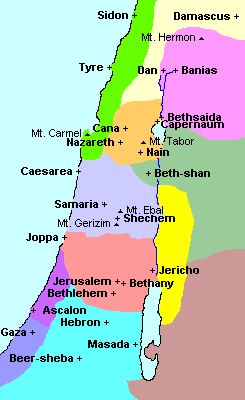Geography Pages
Palestine at the time of Jesus
All boundaries, and borders of countries, are approximate
The territory controlled by a king or people varied from time to time, and was often disputed by other peoples. The coastline of the Dead Sea varies from year to year according to rainfall and usage. An approximation to the modern coast-line is generally used in the maps.
 |
|
|
|
Judea was what remained of the tribal territory of Judah, with
the capital at Jerusalem. Herod the Great ("king of the Jews")
ruled over a larger area,
which was also referred to as "Judea" In his time (40-4 BC)
the kingdom
also included Gaza, Samaria, Galilee, Perea, Idumaea, and parts of
Ituria and Trachonitis. Herod the Great did not want any of his successors to be greater then he had been, so he arranged that on his death the kingdon would be divided up into four smaller "tetrarchies" or quarters |
|
|
Samaria was the original territory of the northern kingdom of Israel. Many of the inhabitants were carried into captivity by the Assyrians ca. 722BC The territory was repopulated with an ethnically mixed population, who intermarried and became "Samaritans". A further revolt, against Macedonian rule, after the conquest of Alexander the Great, resulted in further scattering of the populace. With the coming of the Romans, Samaria was assigned to the kingdom of Herod the Great (30BC). On Herod's death Samaria was ruled by Herod's son Archelaus (4BC-AD6), by Roman Procurators, and by Herod Agrippa (AD41-44) |
| The Galilee was part of the Northern Kingdom which was over-run by the Assyrians ca. 732BC. Following the Maccabean revolt of 164BC the Galilee was annexed to Judah and Samaria. In 63BC Pompey captured much of the Galilee and made it into a Roman province. Herod the Great (40-4BC) took control of the Galilee, Judea, and Perea; on his death he did not want anyone else to have a kingdom as large as his had been, so he divided it into four smaller kingdoms between some of his sons. He gave the Galilee and Perea to his son Herod Antipas | |
| The Decapolis (Greek for "ten towns") was a federation of ten cities with predominantly Hellenistic (Greek) cultures. Bethshan, also called Bethshean, was a city with a long history, from the Chalcolithic period up until Crusader times. It is the subject of ongoing archaeological investigations, which have uncovered acres of buildings and mosaics. ca. 1,468 BC Bethshan was captured by the Egyptian Pharaoh Thutmose III, and the culture became markedly Egyptian. At the time of the Israelite conquest, the Canaanites held out against the Israelites (Joshua 17:11-13, Judges 1:27-28). Archaeological and Biblical evidence suggests that the city fell to the Philistines (II Samuel 31:8-13) and that it was eventually captured by David and became one of Solomon's tax districts (I Kings 4:7 & 12). After being captured by Alexander the Great in 333 BC Bethshan was renamed Scythopolis; this was the name used for it during New Testament times. After the Arab conquest in AD 640 its name was changed back to Beisan (the Arabic form of Bethshan) | |
| Perea, meaning "beyond", was to the East of (beyond) the Jordan. Perea had been claimed by the Maccabees, ca. 200 BC, and by the time of Jesus the population was mainly Jewish. It was part of the tetrarchy of Herod Antipas, along with the Galilee. | |
| Herod the Great left Ituria and Trachonitis to his son Philip (the first husband of Herodias). In Old Testament times Ituria was the homeland of one of the tribes of Ishmael; their descendents were marauders who gave the Romans quite a bit of trouble. Trachonitis was a region of rocky ground and lava beds (the equivalent of badlands) and was also the home of marauding robbers until Herod the Great set up military settlements of Idumaeans and Jews to enforce the peace. | |
| The Phoenicians had declined in importance as a nation since the time of the Old Testament. They had lost most of their warships when they fought on the side of Xerxes at the Battle of Salamis (near Athens in Greece, 480 BC), had been conquered by Alexander the Great, ca. 333 BC, and their great colony of Carthage had been annihilated by the Romans in 146 BC at the conclusion of the Punic Wars. | |
| Syria was a mostly desert region surrounding Damascus, which was a center for trade. | |
| Askalon or Ashkelon had been one of the Philistine cities; it had had a series of different rulers, but by New Testament times it had gained independence as an autonomous city. | |
| Gaza had also been a Philistine city, but later came under Jewish control. Herod the Great held Gaza for a short time, but on his death the Romans put it under the control of the Roman governor of Syria. | |
| "Idumaea" was the Greek form of the name Edom, but by the time of the New Testament Idumaea covered more territory than the original Edom. Herod the Great was an Idumaean whose ancestors had been forcibly converted to Judaism. | |
| The Nabataeans appear to have moved from the Arabian desert into Nabataea at the time the Edomites moved westward into the region of Judah (ca. 400 BC). They built the city of Petra in the mountains south and east of the Dead Sea, and successfully held off the Romans until AD 106. Herod the Great's mother was a Nabataean, and Herod Antipas was married to a Nabataean princess, whom he divorced in order to be able to marry Herodias. |
![]() Go here for the History of the period.
Go here for the History of the period.
Copyright © 1999 Shirley J. Rollinson, all Rights Reserved